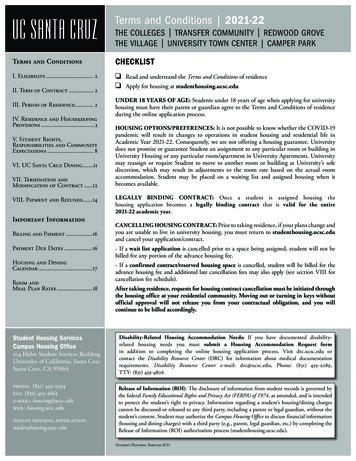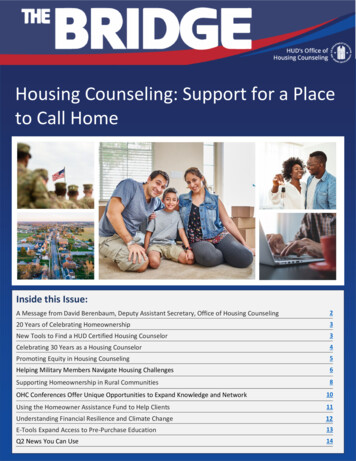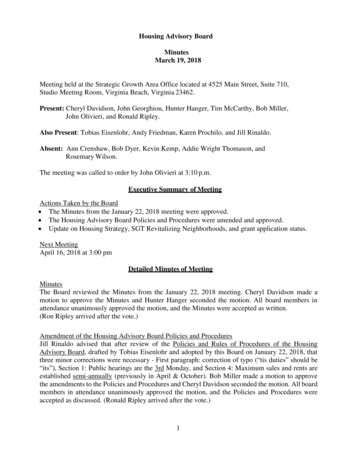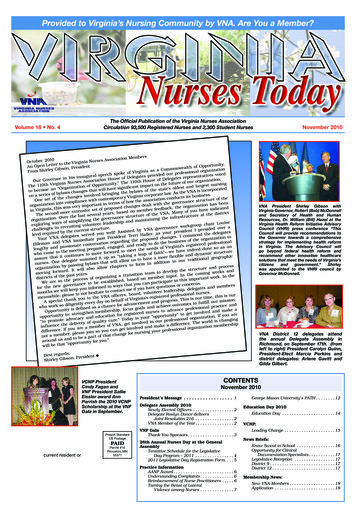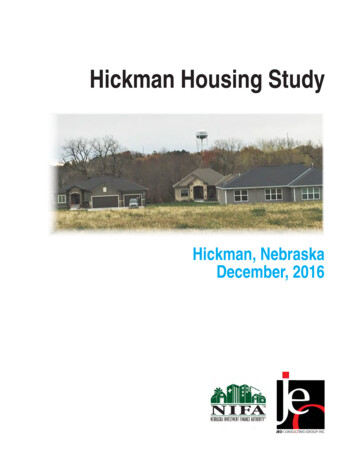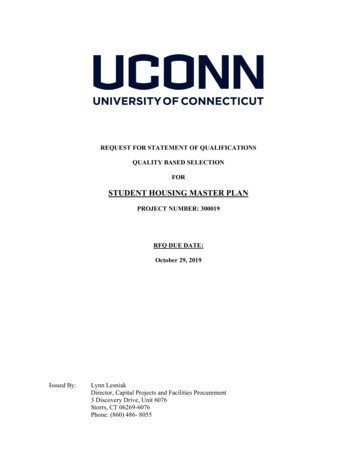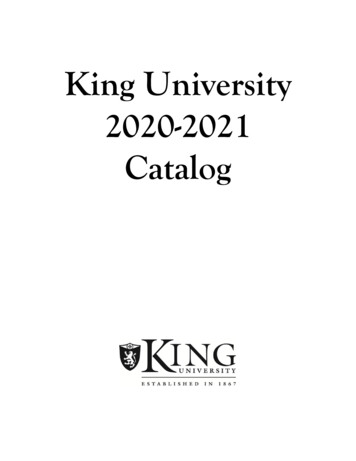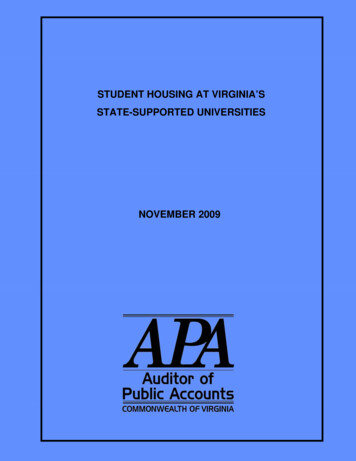
Transcription
STUDENT HOUSING AT VIRGINIA’SSTATE-SUPPORTEDSTATESUPPORTED UNIVERSITIESNOVEMBER 2009
SUMMARYEach of Virginia’s 14 state-supported universities, as well as Richard Bland College and theUniversity of Virginia’s College at Wise, has on-campus student housing. Since 2000, full-timeenrollment at Virginia’s state-supported universities has increased 23 percent. Increases in enrollment thatincreased the first year students who are required to live on-campus, improvements in on-campushousing, and changes in mandatory on-campus housing requirements have increased demand for oncampus housing.Virginia’s state-supported universities have different policies as to whether students mustlive on-campus based on each university’s goals for their on-campus housing programs. While tenuniversities, along with the University of Virginia’s College at Wise, require students to live in oncampus housing their first year; only Virginia Military Institute, Radford University, ChristopherNewport University, and Longwood University require students to live in on-campus housingbeyond their first year.Since 2000, nearly all of the universities have increased on-campus housing, but only abouthalf of the universities have increased on-campus housing at a rate faster than their full-timeenrollment growth. Several urban universities, including Christopher Newport University, VirginiaCommonwealth University, George Mason University, Old Dominion University, and Norfolk StateUniversity, have increased their on-campus housing and their percentage of students who live oncampus as they have broadened from being principally commuter universities to become regionaluniversities.Nearly all universities plan to add on-campus housing to meet this increased demand. Theability of Virginia’s state-supported universities to work with their foundations and other thirdparties to create financing options allows the universities to expand their on-campus housing. Theuniversity’s foundations have been able to leverage their assets and borrow funds without increasingthe direct debt on the university’s financial statements. However, this has not been without on-goingobligations for the universities in the form of operating lease arrangements and commitments to fillfoundation-owned facilities first.In the second phase of this project, we will review the impact of the growth of on-campushousing and mandatory on-campus residence requirements on the students, on the cost of attendance,and on the community housing markets. We will also review the impact of the shift in fundingsources on both the universities and their foundations. Additionally, we will review the universities’relationships with off-campus housing providers and how universities work to meet the needs ofstudents who live in the local community.
-TABLE OF CONTENTS–PagesSUMMARYINTRODUCTION1AUDIT OBJECTIVES, SCOPE, AND METHODOLOGY1-2MANDATORY ON-CAMPUS HOUSING POLICIES2-3ENROLLMENT TRENDS AND HOUSING OCCUPANCY RATES4-6ON-CAMPUS HOUSING DEMAND6-8CONSTRUCTION, LEASING, AND THIRD-PARTY CONTRACTS8-9CONSTRUCTION AND FUNDING ARRANGEMENTSCONCLUSIONS9-1011TRANSMITTAL LETTER12-13APPENDIX – UNIVERSITY SURVEY RESULTS14-18
IntroductionEach of Virginia’s 14 state-supported universities, as well as Richard Bland College and theUniversity of Virginia’s College at Wise, has on-campus student housing. Historically, universitieshave funded construction of dormitory style buildings either through reserves resulting from specialfees to accumulate construction funds or by issuing revenue bonds through the state Department ofTreasury.Over the past few years, nearly all universities have added on-campus or universityassociated housing. Often the university foundations or other third-parties fund the construction orpurchase of this new housing through financing arrangements that do not create new debt on theuniversity’s financial statements. However, contracts with foundations or third-parties building thehousing may result in the university having on-going obligations to use this student housing.These obligations may include having the university lease buildings that the foundation eitherconstructed or purchased, assigning students first to the foundation-owned housing, or managingfoundation-owned buildings. In most cases, contracts for these arrangements require the universityto guarantee a certain level of occupancy or to guarantee the foundation’s debt payments. Othercontracts for similar arrangements allow the university to operate the student housing and pay thefoundation lease payments that mirror the foundation’s debt payments.For many of the universities, the past decade has been a period of added student enrollmentas well as added student housing capacity. Additionally, universities also have differing policies asto when students must live on-campus. Construction of additional student housing and changes tomandatory residency requirements affect both the economic viability of university owned, operated,or contracted housing as well as off-campus community housing.Audit Objectives, Scope, and MethodologyThis review is a study in two phases that we will accomplish over a two-year period. Thefirst phase of this review examines University housing policies and other internal operations. Thesecond phase will examine the affect of University housing on the community and some housingalternatives and is scheduled for completion next year.Phase One Objectives compare the various university policies relating to mandatory on campus housing; discuss enrollment trends, housing inventories, and on-campus occupancy rates; and provide an overview of the financial arrangements that universities have with both theirfoundations and other third-parties.1
Phase Two Objectives evaluate the financial impact that third-party financing arrangements have on both thestudent and the university; review the effect of foundation debt issued to construct student housing projects on theoverall debt policies of the combined university and foundation operating entity; compare the student cost of various housing options both within and among theuniversities; summarize the financial affect that these student housing arrangements have on both theindividual universities and the public or private organizations, both short-term and longterm; and review and evaluate the impact of university housing policies, including mandatory oncampus housing, on the local off-campus housing market.The Auditor of Public Accounts conducted research by reviewing and analyzing theuniversities’ websites, policies, and procedures, and performing one-on-one interviews at theuniversities to gain an initial understanding of the housing programs at each university. Auditorssurveyed and interviewed representatives from all 14 of Virginia’s state-supported universities, aswell as Richard Bland College and University of Virginia’s College at Wise. Both the survey andinterview included issues relating to housing inventory, occupancy, mandatory on-campus housingpolicies, and other information to support an understanding of the university’s housing environment.We also reviewed with university officials the contracts and arrangements related to on andoff-campus housing construction or operation with third parties (including university foundations).Auditors also reviewed and evaluated each of the university’s policies and procedures, enrollmenttrends, housing inventory, third-party arrangements, and effects of these arrangements.Mandatory On-Campus Housing PoliciesGenerally, the goals of student housing and residential life at each of Virginia’s statesupported universities are to ensure its students have desirable living arrangements, positiveacademic experiences, and social growth through programs and services provided through oncampus living. In an effort to ensure the university meets these goals, some universities require thatcertain students live in on-campus housing.More than half of the universities require incoming freshmen to reside on-campus, and fouruniversities require both freshmen and some upperclassmen to reside in on-campus housing.Another university plans to implement a requirement for some upperclassmen to live on-campusbeginning in fall 2010. There is a consensus among the universities that requiring freshmen to livein on-campus student housing allows students to focus more on their academics, receive positivelearning experiences through residential hall activities, and develop personal and communityrelationships, all while living in a safe environment during their transition to college studies.2
Virginia Military Institute requires Cadets to live on-post in Barracks for their entire periodof attendance. Radford University generally requires students to live on-campus through their firstfour semesters (generally two years) of full-time attendance. Longwood University generallyrequires students to live on-campus until the semester after they have completed at least 89 hours ofcoursework, usually their first three years of full-time attendance. Both Longwood University andRadford University allow students who otherwise must live on-campus to request exceptions to theserequirements.Starting in fall 2010, Christopher Newport University plans expand their residencyrequirement from all first and second year students to also require third year students to live oncampus until they receive 89 or more credits. Similarly, in fall 2010, the University of MaryWashington will be implementing a policy for all sophomores, as well as all freshmen, to reside oncampus.On-Campus Housing PoliciesVirginia Military InstituteLongwood UniversityRadford UniversityRequires Freshmen tolive on CampusYesYesYesChristopher Newport UniversityYesUniversity of Mary WashingtonCollege of William and MaryJames Madison UniversityUniversity of VirginiaUniversity of Virginia's College at WiseVirginia State UniversityVirginia TechGeorge Mason UniversityNorfolk State UniversityOld Dominion UniversityRichard Bland CollegeVirginia Commonwealth pperclassmento live on-CampusYes (all Cadets)Yes (three years)Yes (two years)Yes (two years,three years as of 2010)No (yes as of 2010)NoNoNoNoNoNoNoNoNoNoNoEven where there are residential requirements, there are exceptions to these policies. Forexample, exceptions to the residency requirement for freshmen or upperclassmen may includestudents who are non-traditional age, married, living close to the university with a parent orguardian, transfer students, or students who have completed military duty.3
Enrollment Trends and Housing Occupancy RatesEnrollment at Virginia’s state-supported universities, Richard Bland College, and theUniversity of Virginia’s College at Wise has increased over the last ten years. We further refinedthis enrollment trend to full-time students, since they generally are the student base that desires oncampus housing. As supported by data submitted to SCHEV, enrollment has increased by 23percent at an average rate of nearly three percent per year since the 2000-01 academic year. Thefollowing chart details the increases in full-time student enrollment by university.Full Time Enrollment Trends 2000 to 2008Christopher Newport UniversityCollege of William and MaryGeorge Mason UniversityJames Madison UniversityLongwood UniversityNorfolk State UniversityOld Dominion UniversityRichard Bland CollegeRadford UniversityUniversity of Mary WashingtonUniversity of VirginiaUniversity of Virginia’s College at WiseVirginia Commonwealth UniversityVirginia Military InstituteVirginia State UniversityVirginia TechTotal Annual Full Time EnrollmentTotal FulltimeTotal Full-time Change inEnrollmentEnrollmentFull-timeFall 2000Fall 526160,99030,464PercentageChange .3%Enrollment for the majority of the universities has increased at an average rate of two percentsince the 2000-2001 academic year. As shown in the chart, this has added about 30,500 full-timestudents over this ten year period. In response, nearly every university has increased its on-campushousing availability. This has allowed half of the universities to house a greater percentage of theirstudents in fall 2008 than in fall 2000.4
Full-time Student Housing Trends 2000 to 2008Percent ofFull-timeStudents StudentsHoused HousedFall 2000 Fall 2000StudentsHousedFall 2008Percent of PercentFull-time change inStudents Full-timeHousedStudentFall 2008 HousingRichard Bland CollegeChristopher Newport UniversityVirginia Commonwealth UniversityOld Dominion UniversityGeorge Mason UniversityUniversity of Virginia’s College at WiseNorfolk State UniversityLongwood UniversityVirginia State UniversityUniversity of Mary WashingtonVirginia Military InstituteVirginia TechCollege of William and MaryJames Madison UniversityUniversity of VirginiaRadford %62.1%33.9%32.0%37.0% 6.1%21.0%Note that at Virginia Military Institute the percentage has not changed since all cadets live inbarracks.Universities where a greater percentage of students live on-campus in fall 2008 than in fall 2000: Christopher Newport UniversityGeorge Mason UniversityNorfolk State UniversityOld Dominion UniversityRichard Bland CollegeUniversity of Mary WashingtonUniversity of Virginia’s College at WiseVirginia Commonwealth University5
Universities where a smaller percentage of students live on-campus in fall 2008 than in fall 2000: College of William and MaryJames Madison UniversityLongwood UniversityRadford UniversityVirginia State UniversityVirginia TechNearly all universities reported that demand for on-campus housing exceeded availability.Approximately half the universities have been able to increase the percentage of students in oncampus housing by adding beds at a rate higher than they have increased their enrollments. Theother universities have seen their percentage of students in on-campus housing decrease since theiradded beds have been at a slower rate of increase than their enrollment increases.Over the past ten years, several urban universities, including Christopher NewportUniversity, Virginia Commonwealth University, George Mason University, Old DominionUniversity, and Norfolk State University, have increased their on-campus housing and theirpercentage of students who live on-campus as they have broadened from being principally commuteruniversities to become regional universities. Those other universities that were principallyresidential universities in 2000 have not increased their on-campus housing to meet their increases inenrollment over this period. As a result, these universities have not been able to continue to meet thedemand for on-campus housing.On-campus Housing DemandGenerally, in the fall, current students apply for on-campus housing for the next academicyear. Accepted freshmen apply for on-campus housing for their fall semester in the spring, alongwith their deposits for their academic enrollments. Universities are able to fill their on-campushousing assignments and assign all available beds in on-campus housing in the spring. However,some students will not reside in on-campus housing in the fall for various reasons, including thosewho decide to enroll in a different university or discontinue their college studies. Those studentswho decide to not attend in the fall forfeit their housing deposits and create housing vacancies thatthe universities usually cannot fill so close to the beginning of classes. While universities aregenerally able to assign all available beds each year, vacancies occur for reasons beyond theuniversity’s control.6
Student Housing Occupancy - Fall 2008University of Virginia's College at WiseVirginia TechCollege of William and MaryJames Madison UniversityRichard Bland CollegeGeorge Mason UniversityLongwood UniversityNorfolk State UniversityUniversity of Mary WashingtonRadford UniversityVirginia Commonwealth UniversityChristopher Newport UniversityVirginia Military InstituteOld Dominion UniversityUniversity of VirginiaVirginia State 2,49358,965Number ofStudentsOccupancyHousedOpen Beds 7096%6,62028296%2,37811595%58,11485199%There is a consensus that the demand for on-campus housing is increasing due to increases infreshmen enrollment and the desire for returning students to remain on-campus. For fall 2008, eachuniversity reached 95 to 100 percent capacities for on-campus housing. William and Mary, VirginiaTech, and the University of Virginia’s College at Wise exceeded their constructed capacity.Universities usually address these over assignments by turning a double room into a triple room orhousing students at local hotels. However, many of these overages are resolved as vacancies occurwhen housed students discontinue their enrollment for various reasons.The number of students in on-campus housing will then fluctuate throughout the fallsemester due to student withdrawals, financial hardships, and other circumstances. Then, generally,there will be significant drop in residents for the spring semester as students do not return for thespring semester for many of these same reasons. Additionally, at some universities, students maystudy abroad in the spring semester and may vacate their on-campus housing. None of theuniversities reached full capacity for spring 2009 because, by then, students that had been previouslyturned away from on-campus housing were financially committed to remaining in off-campushousing.The occupancy rates shown demonstrate the demand for on-campus housing that exceedsavailability. According to university housing directors, various factors are at work in the increased7
demand for on-campus housing. Among these are construction of more desirable apartment styleresidences, awareness of campus safety issues, increases in on-campus amenities and residentialprogramming such as honors dorms, and improvements in on-campus dining choices andrecreational activities. External factors, such as the lack of affordable or suitable off-campushousing options, also create more demand for on-campus housing. In an effort to attract and retainthe desired residential student population, universities have explored various options for meeting thedemand for more space and quality residential communities.Construction, Leasing and Third Party ContractsAll Universities, with the exception of Virginia Tech, University of Virginia, University ofVirginia’s College at Wise, Virginia Military Institute and James Madison University, have financialcontracts with their foundations or other third parties in relation to student housing. In manyinstances, the students and parents are unaware of the underlying transactions, since the universityassigns, operates, secures, programs, and bills these facilities in the same manner as the rest of theuniversity’s on-campus housing.We identified four basic types of contracts involving on-campus housing owned byfoundations or other third parties. The most common contract involves the university’s real estate foundation purchasing orconstructing housing close to the academic campus and then working with the universityto provide that facility as on-campus housing. As an example, a University real estatefoundation financed, bought, and built housing, which it then allows the University tooperate as on-campus housing in exchange for a share of the rental income. Someuniversities have entered into support agreements with their foundations that require theuniversities to assign students to foundation owned properties to maintain a certainoccupancy level, usually 95 percent. A second type of contract is where the university enters into an operating lease agreementfor a fixed cost to have access to student housing units constructed and owned by auniversity foundation. These universities have arrangements with their foundations thatkeep the assets and liabilities associated with the construction and financing off theuniversity’s balance sheet. In almost every case, the University is responsible formanaging the buildings while the value of the building and the related debt remain on thefoundation’s financial statements and not the university’s financial statements. A third type of agreement is similar, but involves the university leasing facilities ownedby a private third-party and then operating those facilities as on-campus housing. Aswith the previous type of agreement, the value of the building and any related debt is notrecorded in the university’s financial statements, since the building is owned by a nonuniversity related entity. The last type of agreement is present at Norfolk State University and Virginia StateUniversity, where the University’s Foundation owns and operates an on-campusapartment complex. At Norfolk State University’s Spartan Suites, the University assigns8
the housing and provides some programming; however, all financial transactions alongwith all operational functions are the responsibility of the Foundation and its contractor.At Virginia State University’s, University Apartments at Ettrick, the University chargesand collects payments for the apartments and forwards those collections to theFoundation which has contracted with a third party vendor to manage the apartments.George Mason UniversityLongwood UniversityOld Dominion UniversityRichard Bland CollegeVirginia Commonwealth UniversityVirginia State UniversityUniversity of Mary WashingtonChristopher Newport UniversityCollege of William and MaryRadford UniversityCollege of William and MaryVirginia Commonwealth UniversityNorfolk State UniversityVirginia State UniversityFoundation constructed or purchased facilitiesthat the University operates as on-campushousing:Foundation owned buildings are leased to theUniversity and operated as on-campus housing:Third-party owned facilities are leased to theUniversity and operated as on-campus housing:Foundation constructed and operated project thatsits on land owned by the University:James Madison University, the University of Virginia, the University of Virginia’s College atWise, Virginia Tech, and Virginia Military Institute do not have any on-campus housing constructedor operated using contracts with foundations or other third parties.As an example of a typical financing arrangement, the Christopher Newport UniversityFoundation built CNU Village, 2, 3, and 4 bedroom apartment units located above retailestablishments; and CNU Apartments. The University and Foundation entered into a contract inwhich the University leases these facilities from the Foundation a cost that covers the Foundation’sdebt service, and assigns them as on-campus housing.The University of Virginia Foundation owns off-campus apartments managed by a thirdparty contractor. The University of Virginia provides information on these apartments along withapartments owned by other private third parties on its off-campus housing web site.Construction and Funding ArrangementsAll but one of Virginia’s state-supported universities plan to renovate, replace, or constructnew dormitories in the immediate future. Based on increased demand for on-campus housing in fall2009, Norfolk State University has just begun the process to study the feasibility of adding oncampus housing. The chart below shows the number of beds universities plan to add to their housinginventory.Renovation and/or construction of these additional facilities require funding. As a result ofrecent budget cuts, many of the colleges and universities are not in a position to carry additionaldebt, thus alternative arrangements have been made in order to keep up with the demand for on9
campus housing. All universities have debt policies that limit the amount of debt the universityplans to carry or the proportion of expenditures the university plans to commit to debt service.When a university foundation pays for construction of a student residence building, neither the debtnor the debt service payments count in computing these debt limits.Student Housing Construction PlansNewResidential HallConstructionRenovationsChristopher NewportUniversityCollege of William andMaryGeorge Mason UniversityJames Madison UniversityLongwood UniversityNew ConstructionFundingAdditionalBedsYesYesRevenue Bonds400-1,000YesYesRevenue Bonds200-250YesYesYesYesYesYes1,192421485Old Dominion UniversityYesNoRadford UniversityRichard Bland CollegeUniversity of MaryWashingtonUniversity of VirginiaUniversity of Virginia'sCollege at WiseVirginia CommonwealthUniversityVirginia Military InstituteVirginia State UniversityVirginia TechYesYesYesNoYesYesYesYesMultiple SourcesRevenue BondsRevenue BondsPrivateConstructionRevenue BondsRevenue BondsFoundationFinancingRevenue BondsYesNoRevenue Bonds125YesNoRevenue Bonds250YesYesNoYesYesYesRevenue BondsRevenue BondsRevenue Bonds3001,223-940135350-400624-Note: The University of Virginia and Virginia State University projects are actually residential hallreplacements.10
ConclusionsOf Virginia’s state-supported universities, only Virginia Military Institute guarantees theavailability of on-campus housing to all its students. Nine of the other thirteen universities, alongwith the University of Virginia’s College at Wise, require students to live in on-campus housingtheir first year. However, only Virginia Military Institute, Radford University, Christopher NewportUniversity, and Longwood University require students to live in on-campus housing beyond theirfirst year.The University of Mary Washington plans on instituting a similar requirement in the comingyear and Christopher Newport University plans on expanding its requirement from two to threeyears. Increases in enrollment, increases in first year students who are required to live on-campus,and changes in mandatory on-campus housing requirements have increased demand for on-campushousing.Additionally, universities have improved programming in on-campus housing; addedamenities such as air conditioning, common rooms, kitchens, and computer access; and created morehonors and specialty dormitories. Other factors including safety and proximity to improved campusfacilities have also created more desire and demand for on-campus housing. Since nearly all of theuniversities reported an over demand for on-campus housing, that means some upper class studentsdo not have the opportunity for on-campus housing.In response, nearly all universities plan to add on-campus housing to meet this increaseddemand. The ability of Virginia’s state-supported universities to work with their foundations andother third parties to create financing options allows the universities to expand their on-campushousing.The university’s foundations have been able to leverage their assets and borrow fundswithout increasing the direct debt on the university’s financial statements. However, this has notbeen without on-going obligations for the universities as operating lease arrangements andcommitments to fill foundation-owned facilities first.In the second phase of this project, we will review the impact of the growth of on-campushousing and mandatory on-campus residence requirements on the students, on the cost of attendance,and on the community housing markets. We will also review the impact of the shift in fundingsources on both the universities and their foundations. Additionally, we will also review theuniversities’ relationships with off-campus housing providers and how universities work to meet theneeds of students who live in the local community.11
November 16, 2009The Honorable Timothy M. KaineGovernor of VirginiaThe Honorable M. Kirkland CoxChairman, Joint Legislative Auditand Review CommissionWe have examined student housing at Virginia’s state-supported universities and submit ourreport entitled “Student Housing at Virginia’s State-supported Universities”. We plan tocomplete this project in two phases. This first phase has as its objectives to: compare the variousuniversity policies relating to mandatory on campus housing, discuss enrollment trends, housinginventories, and on-campus occupancy rates, and provide an overview of the financial arrangementsthat universities have with both their foundations and other third-parties.We plan to complete the second phase of the project in November 2010, which will reviewthe impact of the growth of on-campus housing and mandatory on-campus residence requirementson the students, on the cost of attendance, and on the community housing markets. We will alsoreview the impact of the shift in funding sources on both the universities and their foundations.Additionally, we will also review the universities’ relationships with off-campus housing providersand how universities work to meet the needs of students who live in the local community.We conducted this performance audit in accordance with generally accepted governmentauditing standards. Those standards require that we plan and perform the audit to obtain sufficient,appropriate evidence to provide a reasonable basis for our findings and conclusions based on ouraudit objectives. We beli
campus housing their first year; only Virginia Military Institute, Radford University, Christopher Newport University, and Longwood University require students to live in oncampus housing - . relationships with off-campus housing providers and how universities work to meet the needs of students who live in the local community. - T A B L E O F .
